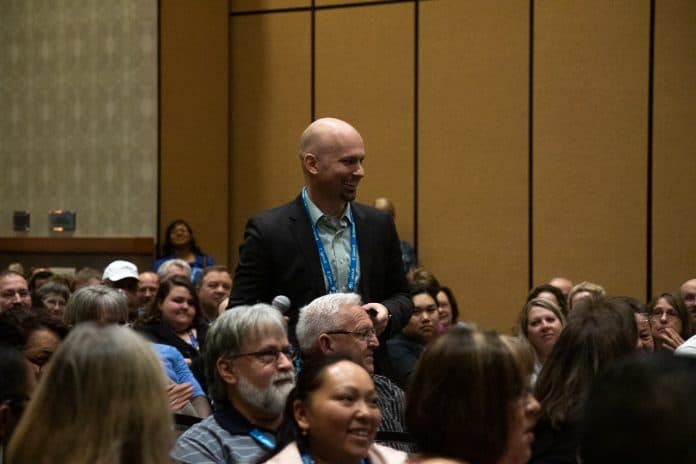Board-certified behavior analyst Patrick Mulick was a recent guest-star on a podcast, “The Autism Helper,” which aired on Nov. 18. Mulick discussed connecting the gaps between transportation and the school, a topic he will discuss at the Transporting Students with Disabilities and Special Needs (TSD) Conference in March.
Mulick is also an educational consultant, and the assistant director of autism and student independence for the Auburn School District in Washington state, as well as a coach with the John Maxwell Team.
Many people in the school transportation world know him for his empowering workshops that are focused on student behavior on the school bus. He has spoken at several STN EXPO conferences, including this past year when he spoke at the TSD Conference, STN EXPO Indy and STN EXPO Reno.
But, the consensus fan-favorite is back. Patrick Mulick will be a keynote speaker at TSD 2020, where he will be opening this year’s conference on March 22 with his presentation, “Creating the Home Field Advantage.”
Related: STN EXPO Speaker Spotlight: Patrick Mulick
Related: Recognizing that Behavior is a Powerful Tool in Student Transportation
Related: Behavior Expert Patrick Mulick Joins STN EXPO Indy General Session Lineup
Related: The Impact of a Simple Smile
Related: TSD Attendees Get to the Heart of Service for Children with Disabilities
In Monday’s podcast that was hosted by Sasha Long, Mulick discussed the importance of looping the transportation staff into meetings, and giving staff members the tools to address the behavior of the child who they transport daily.
“I’ve been talking to bus drivers for years and the number one comment I get from bus drivers: That information was awesome, but do the teachers know that?”
Mulick discussed how he has been given the platform to be able to share the same messages he’s been sharing with transportation staff to special education teachers.
He provided five action items to the teachers on what steps they can take to encourage conversations with transportation staff.
-
- Treat the bus driver like an educator. If someone has the capacity to support a child in any way that is going to influence their day, then they are an educator.
- Make sure that transportation staff is aware of big stressors for children who have autism and the ways they can be supported, as well as the stressors that transportation can have. Some children may experience a behavior change when transitioning between activities. One of the biggest transitions students are going through is leaving the comforts of their home, boarding a commercial vehicle and going to school.
- As teachers are duplicating handouts for their classroom, they should make a copy for the bus driver or bus aide if it could benefit them.
- Support reinforcing positive behaviors and discuss reinforcement with the transportation staff. Provide incentives to the bus drivers or aides that they can use with the students. For instance, Mulick said if a kid acts well on the school bus, he could either receive that positive reinforcement right then, or he could receive something on his desk when he walks into class. Also, bus drivers should be invited to professional development training and should be included in conversations.
- Share the celebrations you have about the student openly. Mulick warned that more often than not, school bus drivers and attendants hear only the negatives about a student before they transport them. He advised changing those perspectives and sharing positive qualities about the student, to avoid negatively influencing someone’s opinion.
Mulick is a huge advocate for the school bus being an extension of the classroom, and he encouraged teachers and bus drivers to make that connection early on. He advised opening communication about the child’s morning bus ride, or their day at school could help the other person during the handoff.
Mulick said it’s easy to get bogged down in the day-to-day operations, and as a former special education teacher himself, he knows the sigh of relief when handing the students off for their bus ride home. However, that is not the end of the child’s day. The student starts the day the minute he/she leaves the comfort of their own home and doesn’t end the day until the student has returned, he noted.
Mulick addressed the importance of teachers communicating the tools and strategies that work in the classroom, from select students to the bus staff.
“We forget that those bus drivers, those transportation staff, they need that information,” Mulick explained. “They need to know what is going to work for those kids, getting them to and from school every day.”
Mulick felt that teachers should invite school bus drivers into their classrooms, so they can see how these strategies are working in the school setting and gain a better feel for how to incorporate those onto the bus. But he also said it should go both way, so teachers should ride a school bus with their students at least once a year. By doing this, they are more engaged in the students’ conversations and can understand their needs from another aspect of the child’s day.
















